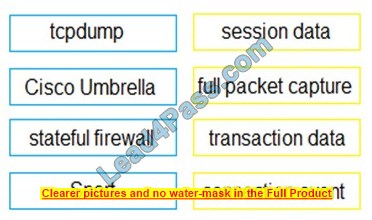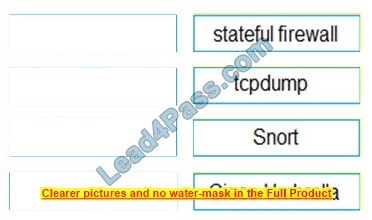
The Cisco 200-201 certification exam refers to passing the “Understanding Cisco Cybersecurity Operations Fundamentals” certification study and then obtaining the CyberOps Associate certification certificate.
We all know that the Cisco 200-201 certification exam is not easy, but practice, before the exam can help us improve the success rate of the exam, Lead4Pass IT provider, provides complete Cisco 200-201 certification practice questions with a 99.5% exam success rate: https://www.leads4pass.com/200-201.html, Help candidates succeed in their certification.
We will encounter many questions in our life, such as candidates for the Cisco 200-201 certification exam: we can find our answers through Cisco official website, Google, Quora, redidit… But such search and reading will use a lot of Time, today I use ChatGPT to answer all the questions that candidates for the Cisco 200-201 certification exam care about, he can save a lot of time, and answer all questions very logically and accurately, of course ChatGPT is not a panacea, it involves privacy and copyright He can’t answer other questions. In the following article, Lead4Pass shares some really effective test questions and answers that ChatGPT can’t answer.
Overview of the Cisco 200-201 certification exam:
The Cisco 200-201 certification exam is a crucial step for professionals looking to advance their careers in the field of networking. As a globally recognized certification, it validates an individual’s ability to design, implement, and troubleshoot enterprise-level networks. The exam covers a wide range of topics, including network security, infrastructure, and automation.
Bypassing the 200-201 exam, individuals demonstrate their mastery of the latest technologies and practices in the field of networking. They also show their commitment to staying up-to-date with the constantly evolving technology landscape, making them highly sought after by employers.
In order to prepare for the exam, individuals must have a strong understanding of the exam objectives, including both theoretical and hands-on knowledge. In this blog, we will explore the importance of hands-on practice in preparing for the Cisco 200-201 certification exam.
The role of hands-on practice in preparing for the exam:
Hands-on practice plays a crucial role in preparing for the Cisco 200-201 certification exam. While theoretical knowledge is important, having the opportunity to apply that knowledge in a practical setting can greatly enhance one’s understanding of the material. Hands-on practice helps to solidify the concepts learned and provides a deeper understanding of how the technology works in real-world scenarios.
In addition to improving understanding, the hands-on practice also helps with retaining information. When individuals actively engage in hands-on activities, they are more likely to remember what they have learned. This is because they are able to apply their knowledge and make connections between different concepts, leading to a more comprehensive understanding of the material.
Furthermore, the hands-on practice also provides individuals with the opportunity to develop their problem-solving skills. By working through real-world scenarios, they are able to apply their knowledge and find solutions to technical challenges. This is a valuable skill that is not only relevant for the 200-201 exam but also in the day-to-day work of a networking professional.
In summary, hands-on practice is a crucial component in preparing for the Cisco 200-201 certification exam. It allows individuals to deepen their understanding of the material, retain information better, and develop their problem-solving skills.
The Benefits of Hands-On Practice:
- A. Improved understanding of concepts
- B. Increased retention of information
- C. Real-world application of theoretical knowledge
- D. Development of problem-solving skills
Hands-On Practice Options:
Using virtual labs
One of the options for hands-on practice for the Cisco 200-201 certification exam is using virtual labs. Virtual labs are simulated environments that mimic real-world networking scenarios and provide individuals with the opportunity to practice their skills.
One of the advantages of virtual labs is their accessibility. They can be accessed from anywhere with an internet connection, making it easy for individuals to practice even if they do not have access to physical equipment. Additionally, virtual labs are often available at a lower cost or for free, making them an affordable option for those on a tight budget.
Virtual labs also provide individuals with the opportunity to practice a wide range of scenarios and technologies. From configuring routers and switches to troubleshooting complex network issues, virtual labs offer a variety of hands-on exercises to help individuals prepare for the 200-201 exam.
In conclusion, virtual labs are a convenient and cost-effective option for hands-on practice for the Cisco 200-201 certification exam. They provide individuals with the opportunity to practice in a simulated environment, helping them to gain practical experience and prepare for the exam.
Participating in online simulations and scenarios
Another option for hands-on practice for the Cisco 200-201 certification exam is participating in online simulations and scenarios. Online simulations and scenarios provide individuals with the opportunity to practice their skills in a controlled environment, allowing them to apply their knowledge and test their understanding.
One of the benefits of online simulations and scenarios is that they are often designed to closely mirror the types of questions that may be encountered on the 200-201 exam. This helps individuals to become familiar with the format of the exam and provides them with the opportunity to practice their test-taking skills.
In addition, online simulations and scenarios often provide immediate feedback on their performance. This allows individuals to identify areas where they need to improve and to focus their studies in those areas.
Furthermore, participating in online simulations and scenarios also provides individuals with the opportunity to work through problems in a step-by-step manner. This helps to build confidence and prepares individuals for the types of tasks they may encounter on the exam.
In conclusion, participating in online simulations and scenarios is a great option for hands-on practice for the Cisco 200-201 certification exam. It provides individuals with the opportunity to practice their skills, become familiar with the exam format, receive immediate feedback, and build their confidence.
Practicing with physical equipment
Practicing with physical equipment is another option for hands-on practice for the Cisco 200-201 certification exam. Working with physical equipment provides individuals with the opportunity to gain hands-on experience in a real-world environment, helping them to better understand the technology and how it works.
One of the benefits of practicing with physical equipment is that individuals are able to work with actual hardware, allowing them to gain hands-on experience with the tools they will be using in the field. This helps them to become familiar with the technology and to understand how it works in a real-world environment.
In addition, practicing with physical equipment also provides individuals with the opportunity to practice their troubleshooting skills. By working with actual equipment, individuals are able to identify and resolve issues that may arise in real-world scenarios.
Furthermore, practicing with physical equipment also provides individuals with the opportunity to work with a variety of devices and configurations. This allows them to gain experience with different types of technology and to become familiar with the different approaches and techniques used in the field.
In conclusion, practicing with physical equipment is a great option for hands-on practice for the Cisco 200-201 certification exam. It provides individuals with the opportunity to gain hands-on experience with actual hardware, practice their troubleshooting skills, and become familiar with a variety of devices and configurations.
Collaborating with peers for hands-on exercises
Collaborating with peers for hands-on exercises is another option for preparing for the Cisco 200-201 certification exam. Working with peers provides individuals with the opportunity to gain hands-on experience in a collaborative environment, allowing them to learn from each other and develop their skills.
One of the benefits of collaborating with peers for hands-on exercises is that individuals are able to learn from one another’s experiences. By working together, individuals are able to see different approaches to solving problems and gain a better understanding of the technology.
In addition, collaborating with peers also provides individuals with the opportunity to practice their communication and teamwork skills. Working with others requires individuals to clearly articulate their thoughts and ideas, helping them to develop their communication skills.
Furthermore, collaborating with peers also provides individuals with the opportunity to learn from each other’s strengths and weaknesses. This allows them to identify areas where they need to improve and to focus their studies in those areas.
In conclusion, collaborating with peers for hands-on exercises is a great option for preparing for the Cisco 200-201 certification exam. It provides individuals with the opportunity to gain hands-on experience in a collaborative environment, learn from one another’s experiences, practice their communication and teamwork skills, and identify areas where they need to improve.
Cisco 200-201 Certification Exam Practice Practice:
| Type | Number of exam questions | Exam name | Exam code | Exam answers |
| Free | 15 | Understanding Cisco Cybersecurity Operations Fundamentals (CBROPS) | 200-201 | Check |
Question 1:
What are the two differences between stateful and deep packet inspection? (Choose two )
A. Stateful inspection is capable of TCP state tracking, and deep packet filtering checks only TCP source and destination ports
B. Deep packet inspection is capable of malware blocking, and stateful inspection is not
C. Deep packet inspection operates on Layers 3 and 4. and stateful inspection operates on Layer 3 of the OSI model
D. Deep packet inspection is capable of TCP state monitoring only, and stateful inspection can inspect TCP and UDP.
E. Stateful inspection is capable of packet data inspections, and deep packet inspection is not
Question 2:
What is the difference between a threat and a risk?
A. Threat represents a potential danger that could take advantage of a weakness in a system
B. Risk represents the known and identified loss or danger in the system
C. Risk represents the nonintentional interaction with uncertainty in the system
D. Threat represents a state of being exposed to an attack or a compromise, either physically or logically.
Question 3:
Which NIST IR category stakeholder is responsible for coordinating incident response among various business units, minimizing damage, and reporting to regulatory agencies?
A. CSIRT
B. PSIRT
C. public affairs
D. management
Question 4:
Which type of data consists of connection level, application-specific records generated from network traffic?
A. transaction data
B. location data
C. statistical data
D. alert data
Question 5:
Which system monitors local system operation and local network access for violations of a security policy?
A. host-based intrusion detection
B. systems-based sandboxing
C. host-based firewall
D. antivirus
Question 6:
Which action prevents buffer overflow attacks?
A. variable randomization
B. using web-based applications
C. input sanitization
D. using a Linux operating system
Question 7:
How does a certificate authority impact security?
A. It validates client identity when communicating with the server.
B. It authenticates client identity when requesting an SSL certificate.
C. It authenticates domain identity when requesting an SSL certificate.
D. It validates the domain identity of the SSL certificate.
Question 8:
What is the difference between tampered and untampered disk images?
A. Tampered images have the same stored and computed hash.
B. Tampered images are used as evidence.
C. Untampered images are used for forensic investigations.
D. Untampered images are deliberately altered to preserve evidence
Question 9:
Refer to the exhibit.

Which field contains DNS header information if the payload is a query or a response?
A. Z
B. ID
C. TC
D. QR
Question 10:
What is the difference between deep packet inspection and stateful inspection?
A. Deep packet inspection gives insights up to Layer 7, and stateful inspection gives insights only up to Layer 4.
B. Deep packet inspection is more secure due to its complex signatures, and stateful inspection requires less human intervention.
C. Stateful inspection is more secure due to its complex signatures, and deep packet inspection requires less human intervention.
D. Stateful inspection verifies data at the transport layer and deep packet inspection verifies data at the application layer
Question 11:
An analyst is using the SIEM platform and must extract a custom property from a Cisco device and capture the phrase, “File: Clean.” Which regex must the analyst import?
A. File: Clean
B. ^Parent File Clean$
C. File: Clean (.*)
D. ^File: Clean$
Question 12:
DRAG DROP
Drag and drop the elements from the left into the correct order for incident handling on the right.
Select and Place:

Correct Answer:

Question 13:
DRAG DROP
Drag and drop the security concept on the left onto the example of that concept on the right.
Select and Place:

Correct Answer:

Question 14:
DRAG DROP
Drag and drop the technology on the left onto the data type the technology provides on the right.
Select and Place:

Correct Answer:

Question 15:
What is the difference between inline traffic interrogation and traffic mirroring?
A. Inline interrogation is less complex as traffic mirroring applies additional tags to data.
B. Traffic mirroring copies the traffic rather than forwarding it directly to the analysis tools
C. Inline replicates the traffic to preserve integrity rather than modifying packets before sending them to other analysis tools.
D. Traffic mirroring results in faster traffic analysis and inline is considerably slower due to latency.
…
For Cisco 200-201 certification exam complete practice questions, please choose Lead4Pass 200-201 dumps: https://www.leads4pass.com/200-201.html, including the latest 264 exam questions and answers in 2023, providing PDF files and VCE Mock exams to help you succeed on the CyberOps Associate certification exam.
Cisco 200-201 certification exam answers:
| Questions | Q1 | Q2 | Q3 | Q4 | Q5 | Q6 | Q7 | Q8 | Q9 | Q10 | Q11 | Q12 | Q13 | Q14 | Q15 |
| Answers | AB | A | D | A | A | C | D | B | B | B | A | IMAGE | IMAGE | IMAGE | A |
| Explain | A threat is any potential danger to an asset. If a vulnerability exists but has not yet been exploited–or, more importantly, it is not yet publicly known–the threat is latent and not yet realized. | HIDS is capable of monitoring the internals of a computing system as well as the network packets on its network interfaces. A host-based firewall is a piece of software running on a single Host that can restrict incoming and outgoing Network activity for that host only. | A certificate authority is a computer or entity that creates and issues digital certificates. CA do not “authenticate” it validates. “D” is wrong because The digital certificate validate a user. CA –> DC –> user, server or whatever. Reference: https://en.wikipedia.org/wiki/Certificate_authority |
Conclusion:
Recap of the importance of hands-on practice for the 200-201 exam
In conclusion, hands-on practice is an essential component of preparing for the Cisco 200-201 certification exam. Whether it be through virtual labs, online simulations, scenarios, practicing with physical equipment, or collaborating with peers, the hands-on practice provides individuals with the opportunity to apply their knowledge, test their understanding, and gain hands-on experience with the technology.
Hands-on practice helps individuals to become familiar with the exam format, practice their test-taking skills, and receive immediate feedback on their performance. It also allows individuals to build their confidence and prepare for the types of tasks they may encounter on the exam.
In addition, the hands-on practice provides individuals with the opportunity to gain hands-on experience with actual hardware, practice their troubleshooting skills, and become familiar with a variety of devices and configurations. By collaborating with peers, individuals are able to learn from one another’s experiences and develop their communication and teamwork skills.
In summary, the importance of hands-on practice for the Cisco 200-201 certification exam cannot be overstated. By incorporating the hands-on practice into their study routine, individuals will be better prepared for the exam and have a higher likelihood of passing.
Final thoughts on preparing for the exam
In final thoughts, preparing for the Cisco 200-201 certification exam requires a combination of studying, hands-on practice, and understanding of the exam format. By incorporating these components into their study routine, individuals will be better prepared for the exam and have a higher likelihood of passing.
It’s important to remember that the 200-201 exam is a comprehensive evaluation of an individual’s understanding of the technology, as well as their ability to apply that knowledge in real-world scenarios. Therefore, it’s essential for individuals to take the time to thoroughly study the material and to engage in hands-on practice to ensure they have a strong understanding of the technology.
In addition, it’s important for individuals to familiarize themselves with the exam format, including the types of questions that may be asked and the format of the exam itself. This will help them to feel confident and prepared on exam day.
In conclusion, preparing for the Cisco 200-201 certification exam requires dedication, hard work, and a comprehensive approach to studying. By incorporating hands-on practice, a strong understanding of the material, and familiarizing themselves with the exam format, individuals will be well-prepared for success on exam day.
Good luck!